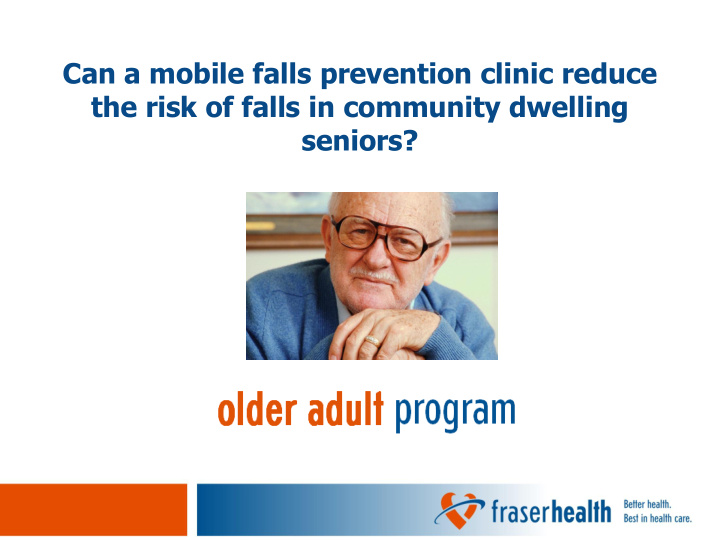



Can a mobile falls prevention clinic reduce the risk of falls in community dwelling seniors? 1
Services • $2.8 billion annual operating budget • 12 acute care hospitals (2,065 patients) • 83 residential care facilities (7,760 beds) • 26,000 staff • 2,500 physicians • 6,500 volunteers 2
Falls Prevention Mobile Clinic 3
Fallscreen - the falls risk calculator 4
Falls Prevention Mobile Clinic Unique Features of the Clinic Accepts patient self-referrals Brings assessments to patients in their communities Works cooperatively with family physicians Partners with local community services who provide space for the clinic, nurses and pharmacists at no cost Reaches seniors who are at high risk but may not yet be falling (prevention) Travels to remote areas Adapts to provide care for Aboriginal populations and cultural groups (in multiple languages) Low cost per patient due to in-kind contributions and no direct involvement of physicians 5
Falls Prevention Mobile Clinic • 180 clinics (from September 2007 to September 2014) • Assessment and interventions provided to over 2700 seniors Visited once Visited twice Visited 3 or more 6
Study Subjects 65 years or older Community, assisted living, senior residence Referred to Falls Prevention Mobile Clinic Screened at high risk for fall Using a walking aid AND / OR one or more falls in last 6 months 8
Follow-up / Outcome Assessment Contacted at 1,3,9 month by phone Review of falls diaries 6 and 12 months face to face Questionnaire: Uptake of recommendations PPA, TUG and SF-36 repeated 9
Follow-up / Outcome Assessment Primary outcome Uptake of clinic recommendations Secondary outcomes Change in PPA score and TUG Rate of falls and related injuries requiring medical intervention Changes in quality of life (SF-36) 10
Preliminary Results (Oct 7 /09- April 10/13) 483 study subjects enrolled 284 subjects completed 12 month follow- up 119 Drop Outs/ Exclusions (25%) No longer want to participate Death Decline in health 364 active subjects with data (6 Month and/or 12 Month) 11
Baseline Characteristics Average Age 84 years (SD 7) 81% female 57% reported a fall in last 6 months 85% using walking aid 64% moderate-very high risk for falls by PPA 12
Preliminary Results Uptake of recommendations at 12 months (n=284) 63% of participants who were recommended to change calcium intake reported making the change 56% of participants who were recommended to change Vitamin D intake reported making the change 27% of participants who were given strength and balance exercises reported initiating the exercises with 45% of those participants still doing the exercises one year after the clinic 24% of follow-up participants reported an increase in activity following the clinic 13
Preliminary Results 12 months follow-up (n=284) 54%(153/284) improved their PPA scores 59% (91/153) improved to a lower Falls Risk category 14
Preliminary Results 12 months follow-up 60% improved TUG scores 80% of those improved by 10% or more 15
Preliminary Results 12 months follow-up 55% experienced at least one fall 25% of falls requiring some medical treatment 9% of falls requiring ER visit 16
Summary Preliminary results encouraging Appears to be good uptake of recommendations Significant improvements in falls risk 17
Acknowledgements Dr. Sonia Singh Ashley Kwon 18
Recommend
More recommend